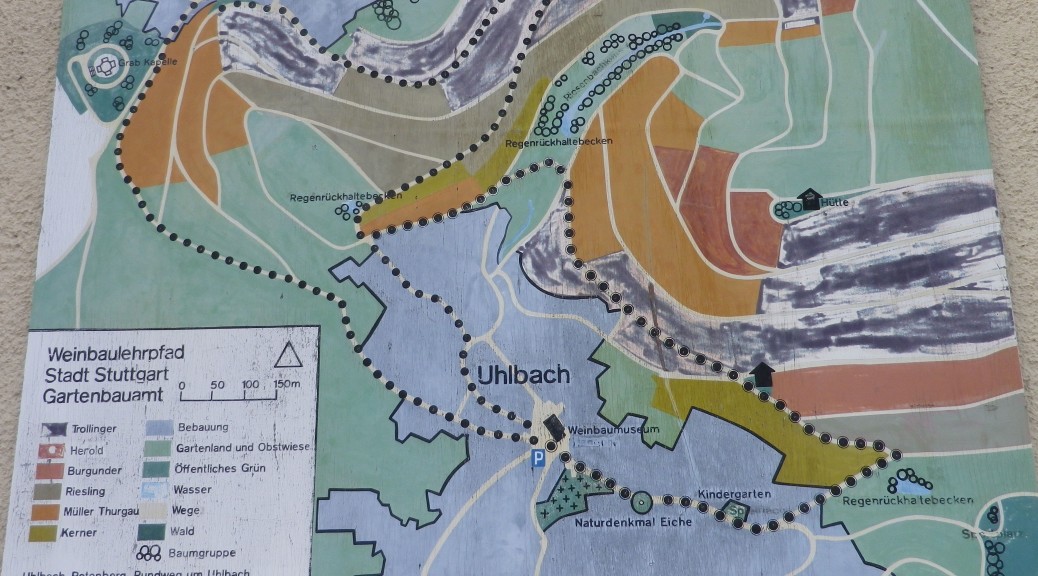What I Learned:
The Remstal district is in the Rems River valley, located a few kilometers northeast of Stuttgart’s city center. With slightly over 600 hectares, the grapes here grow in soil that is 90% keuper (consisting of marl and limestone). Trollinger is the predominant varietal followed by Riesling, Kerner (a Trollinger and Riesling cross), Schwarzriesling (Pinot Meunier), Lemberger, Mueller-Thurgau, Spaetburgunder (Pinot Noir), Dornfelder, Portugieser, and Silvaner, in that order. The information about this area was provided by the Remstalkellerei, a wine cooperative (and wine shop) that makes and markets wines from this district in large amounts. (This is a popular winery whose products grace the shelves of many German supermarkets, especially in the Stuttgart area.)
A few kilometers south of the Remstal is the wine area of Rotenberg, Uhlbach and Untertuerkheim, the small towns along the Neckar, now within Stuttgart’s city limits. As the Weinbaumuseum in Uhlbach notes, Stuttgart is the only city in Germany to have grapes growing within its limits. According to the Collegium Wirtemberg, a little more than 70 per cent of the grapes grown in this district are red varietals. Trollinger being the most predominant, although other red varietals include Spaetburgunder and Lemberger. Riesling is also here, not surprisingly, as well as Weissburgunder (Pinot Blanc), Grauburgunder (Pinot Gris) and Silvaner.
These areas, both easily accessible from downtown Stuttgart by metro rail, have a serious concentration of vintners, wineries, wine taverns and shops for visitors to enjoy. Below are some of the wines produced within both these areas of the southern part of the Wuerttemberg’s Remstal-Stuttgart district, which I tried while there.
What I Tasted:
2013 Traminer QbA, Halbtrocken, Weingut Stadt Stuttgart: light-medium gold, in color, floral and pear notes, this wine has very little acidity.
2012 Silvaner (Moenchberg), trocken; Qualtitaetswein; Weingut Schwarz, in Untertuerkheim: apricot flavors, slightly minerally, tart vice acidic on tongue, smooth finish, medium mouthfeel.
2012 Weisswein Cuvee Weinsteige QbA Trocken, Weingut Stadt Stuttgart: a blend of Pinot Blanc, Rivaner and Riesling, this wine had medium gold color, and a spicy, tart, and buttered toast taste to it.
2012 Chardonnay, Edition Wirtemberg, trocken; Qualtitaetswein; Collegium Wirtemberg, Weingartner Rotenberg und Uhlbach: pear, melon, interesting. A light mouth feel.
2012 Stuttgarter Riesling Sekt, Brut, Weingut Stadt Stuttgart: pale gold with fine, streaming bubbles, this Sekt had floral and fruity notes, with a hint of toast.
2012 Sauvignon Blanc, Spaetlese; Winnender Holzenberg, Weingut Michael Maier; Schwaikheim: melon, honey, floral, medium mouth feel, long finish.
2012 Spaetburgunder Blanc de Noirs, trocken; Qba; Weinmanufactuer Untertuerkheim: a dry, medium to full mouthfeel, minerally-tasting wine, with a slight hint of floral perfume.
2012 Semsakrebsler, Dornfelder Weinsteige QbA Trocken, Weigut Stadt Stuttgart: a rich, purple-red color, with mild tannins, hints of cherry and oak.
2011 Villa Gemmingen Rotwein-Cuvee Moenchhalde QbA Trocken: a very dry cuvee of Spaetburgunder, Lemberger and Dornfelder, dark red in color, with hints of cherries, oak and smoke. The Dornfelder does come through in this blend.
2011 Riesling Brut, Sekt b.A., Weinmanufaktur Untertuerkheim: clear medium gold with a constant stream of fine bubbles; floral notes, with a bit of tartness; a very interesting sparkling wine.
2011 Rose-Sekt, Extra Trocken, Weingut Stadt Stuttgart: a dry, rose sparkling wine with light salmon coloring; red fruits and a spiciness came through, as well as a slight tannic aftertaste.
2009 Acolon, Weingut Schwarz, in Untertuerkheim; full mouth feel, velvety feel on the palate, cherries and oak, smoky notes.
